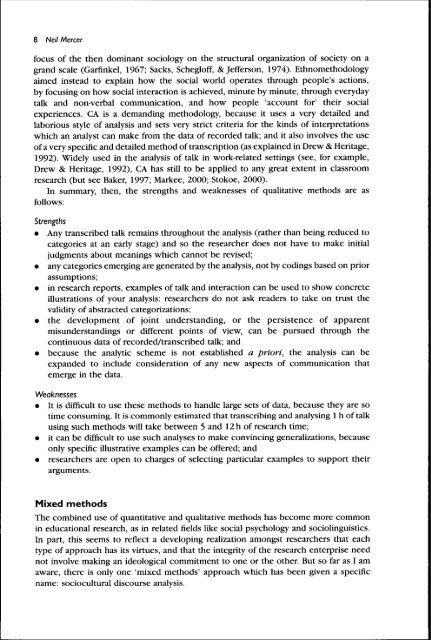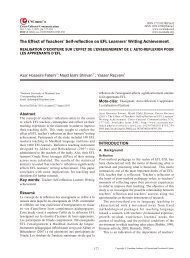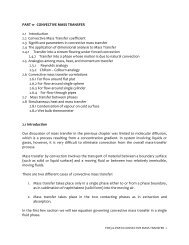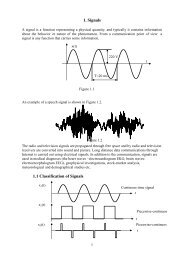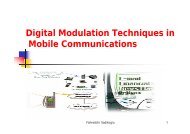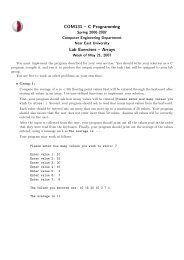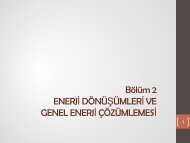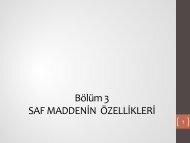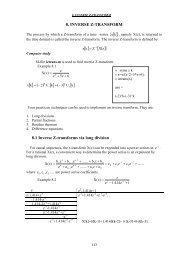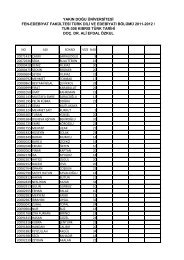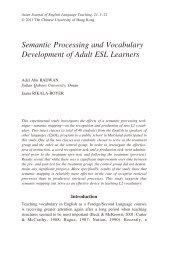8 Neil Mercerfocus <strong>of</strong> the then dominant sociology on the structural organization <strong>of</strong> society on agr<strong>and</strong> scale (Garfinkel, 1967; Sacks, Schegl<strong>of</strong>f, & Jefferson, 1974). Ethnomethodologyaimed instead to explain how the social world operates through people's actions,by focusing on how social interaction is achieved, minute by minute, through everyday<strong>talk</strong> <strong>and</strong> non-verbal communication, <strong>and</strong> how people 'account for' their socialexperiences. CA is a dem<strong>and</strong>ing methodology, because it uses a very detailed <strong>and</strong>laborious style <strong>of</strong> <strong>analysis</strong> <strong>and</strong> sets very strict criteria for the kinds <strong>of</strong> interpretationswhich an analyst can make from the data <strong>of</strong> recorded <strong>talk</strong>; <strong>and</strong> it also involves the use<strong>of</strong> a very specific <strong>and</strong> detailed method <strong>of</strong> transcription (as explained in Drew & Heritage,1992). Widely used in the <strong>analysis</strong> <strong>of</strong> <strong>talk</strong> in work-related settings (see, for example.Drew & Heritage, 1992), CA has still to be applied to any great extent in <strong>classroom</strong>research (but see Baker, 1997; Markee, 2000; Stokoe, 2000).In summary, then, the strengths <strong>and</strong> weaknesses <strong>of</strong> qualitative methods are asfollows:Strengths• Any transcribed <strong>talk</strong> remains throughout the <strong>analysis</strong> (rather than being reduced tocategories at an early stage) <strong>and</strong> so the researcher does not have to make initialjudgments about meanings which cannot be revised;• any categories emerging are generated by the <strong>analysis</strong>, not by codings based on priorassumptions;• in research reports, examples <strong>of</strong> <strong>talk</strong> <strong>and</strong> interaction can be used to show concreteillustrations <strong>of</strong> your <strong>analysis</strong>: researchers do not ask readers to take on trust thevalidity <strong>of</strong> abstracted categorizations;• the development <strong>of</strong> joint underst<strong>and</strong>ing, or the persistence <strong>of</strong> apparentmisunderst<strong>and</strong>ings or different points <strong>of</strong> view, can be pursued through thecontinuous data <strong>of</strong> recorded/transcribed <strong>talk</strong>; <strong>and</strong>• because the analytic scheme is not established a priori, the <strong>analysis</strong> can beexp<strong>and</strong>ed to include consideration <strong>of</strong> any new aspects <strong>of</strong> communication thatemerge in the data.Weai
<strong>The</strong> <strong>analysis</strong> <strong>of</strong> <strong>classroom</strong> <strong>talk</strong> 9Sociocultural discourse <strong>analysis</strong>'Sociocultural' discourse <strong>analysis</strong> differs from 'linguistic' discourse <strong>analysis</strong> in beingless concerned with the organizational structure <strong>of</strong> spoken language, <strong>and</strong> more withits content, fimction, <strong>and</strong> the ways shared underst<strong>and</strong>ing is developed, in socialcontext, over time (as described in more detail in Mercer, 2005, 2008). As withethnography <strong>and</strong> CA, reports <strong>of</strong> such research are usually illustrated by selectedextracts <strong>of</strong> transcribed <strong>talk</strong>, to which the analyst provides a commentary. <strong>The</strong> basicdata thus remains throughout the whole process, as with most qualitative methods.But this qualitative <strong>analysis</strong> is then integrated with quantitative <strong>analysis</strong>. This mightinvolve using a concordancer to assess the relative incidence <strong>of</strong> 'key words' orcollocations <strong>of</strong> words in the data (as described under sociolinguistic discourse<strong>analysis</strong>' above). Qualitative analyses <strong>of</strong> particular interactions can also be used togenerate hypotheses which can then be tested systematically, <strong>and</strong> quantitatively, on alarge text or series <strong>of</strong> related texts. For example, a researcher may want to see if atechnical term introduced by a teacher is taken up by students later in their groupbasedactivity. And by locating all instances <strong>and</strong> collocations <strong>of</strong> a term in thetranscription file, the way it is used by teachers <strong>and</strong> students in relation to their jointactivity can then be considered (see, for example. Mercer, 2000: Chapter 3; Wegerif& Mercer, 1997). A sociocultural method has been used to analyse <strong>and</strong> evaluate the<strong>talk</strong> <strong>of</strong> children working together in pairs or groups (Lyle, 1993, 1996; Mercer &Littleton, 2007), sometimes on computer-based activities (Kumpulainen & Mutanen,1999; Wegerif & Scrimshaw, 1997).Conclusions<strong>The</strong> <strong>analysis</strong> <strong>of</strong> <strong>classroom</strong> <strong>talk</strong> brings with it many challenges for researchers, <strong>and</strong> nomethod (or methodology) devised so far is without its limitations. But new entrants tothis field<strong>of</strong> research can take advantage <strong>of</strong> the considerable amount <strong>of</strong> work, over somedecades, that researchers <strong>of</strong> several disciplines have put into the development <strong>of</strong>methods for analysing interaction. <strong>The</strong>re is no virtue in re-inventing wheels, or inignoring the methodological problems with which others have grappled (<strong>and</strong> whichthey have at least partly overcome).With their various strengths <strong>and</strong> weaknesses, it may seem logical to use two or moremethods <strong>of</strong> analysing <strong>talk</strong> in a complementary way. In doing so, however, it is importantto recall a point made earlier in this paper - that different methods may embodydifferent conceptions <strong>of</strong> the nature <strong>of</strong> <strong>talk</strong> <strong>and</strong> what counts as a valid <strong>analysis</strong>. As Snyder(1995) argues on the basis <strong>of</strong> her studies <strong>of</strong> children's computer literacy, the successftilcombination <strong>of</strong> different methods depends on research being underpinned by asensitive, flexible theoretical framework' for underst<strong>and</strong>ing the complexity <strong>of</strong> real-lifeevents. Given such a framework, I believe there are ways <strong>of</strong> combining at least somemethods which will satisfy most reasonable concerns about validity <strong>and</strong> methodologicalconsistency. While underlying conceptions <strong>of</strong> what constitutes a valid course <strong>of</strong> enquiryare bound to be influential, <strong>and</strong> rightly so, my own view is that some choices <strong>of</strong> method- such as whether to use qualitative or quantitative methods, or to use an experimentaldesign or naturalistic observations - should not be too easily determined by ideologicalcommitments. I find arguments that only qualitative research can deal with the humanreality <strong>of</strong> school life, or that only quantitative research amounts to real science, equallyunconvincing. Instead, researchers should accept that various methods - <strong>and</strong><strong>methodologies</strong> - have their distinctive strengths <strong>and</strong> weaknesses, <strong>and</strong> that by asking


